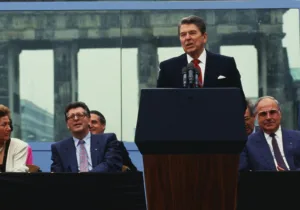Review of The Governance of China, All Volumes, by Xi Jinping, Foreign Languages Press, 2014-2022.
In The Good Earth (1931), Presbyterian missionary, fluent Chinese linguist, and future Nobel laureate Pearl S. Buck introduced the American to the Chinese people, through the fictional but realistic account of farmer Wang Lung, the former slave he made his wife, O-lan, and other Chinese commoners confronting poverty, obscurantism, love, and loss at the outset of a century of social revolution. “He had no articulate thought of anything; there was only…turning this earth of theirs over and over to the sun, this earth which formed their home and fed their bodies and made their gods” ([2004] 29-30). Although the lives of the Chinese people from before time became counted were defined by the ceaseless struggle for food and for survival, the authoritarian political system since the destruction of the Manchu dynasty has presented the bewildering spectacle of almost relentless ideological transformation, the most recent manifestation of which is styled, “Xi Jinping Thought on Socialism with Chinese Characteristics for a New Era,” formally received as party doctrine in 2017 and constitutionally established the following year.
The four volumes of The Governance of China—the most recent of which just appeared—furnish an edited, translated, and apparently complete collection of all the prepared public remarks of General Secretary of the Central Committee of the Communist Party and President Xi Jinping, arranged in chronological order according to subject matter. The contents of the first volume run from 12 November 2012 to 13 June 2014, and consist of seventy-two speeches, three interviews, two meeting minutes, one memorandum, and one public letter, along with a surprisingly detailed official biography that ought to intrigue any foreign intelligence unit. Volume two covers the period from 18 August 2014 to 29 September 2017, and comprehends ninety-seven speeches, two meeting minutes, and two directives. The third volume ranging from 18 October 2017 to 13 January 2020 opens with the profoundly important, “Secure a Decisive Victory in Building a Moderately Prosperous Society in All Respects and Strive for the Great Success of Socialism with Chinese Characteristics for a New Era,” a kind of ‘state of the union’ address to the Communist Party that outlines the overarching goals of the Jinping regime. The fourth and current volume, finally, covers the period from 3 February 2020 to 10 May 2022, and comprehends 106 speeches, two letters, and one memorandum.
Sociologically, the material in its context reminds one of the ceremonial rôle of the Queen of England, continually dotting the institutional landscape with platitudinous uplifting speeches tailored to the domestic or foreign, and to the public or private audience. The diffuse presidential conversation is also characteristically so functional in nature that it could just as easily have been delivered by a Western democratic head of state or government. But a consistent conceptual distinction nevertheless emerges. When addressing organs of the Communist Party, the Chinese President invariably professes Marxism, constantly commending to the attention of his comrades the ideological inheritance of Mao Zedong Thought, Deng Xiaoping Theory, the “Three Represents” of Jiang Zemin, and the “Scientific Outlook on Development” of Hu Jintao, among other concepts, defining China in the course of the political testament emphasized above as, “a socialist country of people’s democratic dictatorship under the leadership of the working class based on an alliance of workers and farmers” (38). Select quotations from Marx, Engels, and Lenin frequently appear in support, although the more sophisticated components of the structural analysis of Das Kapital such as the theory of surplus value or the principle of alienated labor seldom, if ever, appear. When addressing almost anyone else, in contrast, Marxism is jettisoned completely in favor of a neoliberal globalism based on institutional improvement and economic interdependence. “We should carry out reform to improve the socialist market economy of China and adhere to the basic state policy of opening up to the outside world…Reform and opening up is always an ongoing task and will never end” (I, 73-75). Therefore the most obvious and consistent discrepancy lies not in any observed or suspected difference between what the Chinese government says and what the Chinese government does, but between what its head says to Communist and to non-Communist audiences.
Both Marxist and liberal tendences of “Xi Jinping Thought” subscribe to the same ideological timeline, which as frequently retold began with the national humiliation of the Opium War of 1840, continued through the New Democratic Revolution of 1919 to 1949, embarked upon a new direction with the inauguration of the reform and opening up policy in 1978, and entered its existing stage with the 2012 announcement of the Two Centenary Goals of a moderately prosperous China by 2021, and of a “prosperous, strong, democratic, culturally advanced, and harmonious” China by 2049. But regarding the former, the reader is soon overwhelmed by the accretion of annotated lists employed to remind party officials of their duty, with Four Cardinal Principles, Five Principles of Peaceful Coexistence, the Chinese Dream, two unswervinglys, three furthers, six centering-ons, two musts, three stricts, three earnests, eight rules, and four malfeasances identified in the first volume alone. It is at once easy to lampoon such Orwellian newspeak, to deprecate the apparent collective hive-mind that should accommodate it, and to wax eloquently about the extreme liberties the Chinese Communists so obviously take with the textual bases of historical materialism. Of much greater urgency and importance for China and for the world however is the accurate assessment of Beijing’s declared and distinctive socialist policy of international peace.
China’s foreign policy is aimed at maintaining world peace and promoting common development. China has stated on numerous occasions that it opposes hegemonism and power politics in all forms, does not interfere in the internal affairs of other countries, and will never seek hegemony or expansion. This is our guiding principle for China’s political system, and for each step we take.
(I, 293)
President Jinping offers to all audiences without exception or qualification the strongest assurances that China shall never initiate imperialist war. Although dictatorships regularly lie, governments, to be effective, must give clear and consistent direction; and the absolute consistency with which the doctrine and practice of preserving international peace is articulated, combined with acknowledgement of the logistical near-impossibility of privately disseminating guidance to the contrary to so many countless people groups and party units ought to raise concern that certain Western, but especially American centers for strategic thought may sometimes wrongly impute ultimate Asian or even world-imperialist intentions to the Chinese government.
“Xi Jinping Thought” regarding the two most perennially suspicious foreign powers furnishes further suggestive evidence of non-hegemonic intentions. Of its 379 total entries, only two directly concern Sino-American relations, one a soundbite (II, 533-34) addressed to the newly elected President Trump, and the other a nearly obligatory (IV, 83-89) speech to the veterans of the reserve army on the anniversary of the opening of hostilities in the Korean War, officially styled the “War to Resist US Aggression and Aid Korea.” But even that sole anti-American address concludes with a reiteration of the unqualified non-violence policy, with President Jinping stating, “Peace, development, and win-win cooperation are the right way forward” (89). Cross-Straits rather than international relations, meanwhile, frame policy regarding Taiwan, classified as the final portion of the Chinese nation to be reintegrated after the successful transitions of Hong Kong and Macau. “No force or people can ever change the historical fact that Taiwan is part of China and that the two sides belong to one and the same China,” President Jinping states. “We people on both sides of the Taiwan Straits are Chinese and share a natural affinity and national identity built of kinship and mutual assistance, a fact that can never be altered by any force or any people” (III, 470). Yet it is crucial to understand that Taiwanese territorial recovery is the sole expansionist objective implied throughout an official oeuvre that otherwise furnishes hardly any comparative political commentary at all.
Chinese President Jinping has placed virtually nothing on record regarding developments in Japan, Vietnam, India, Indonesia, or in any other regional strategic competitor; and thus the onus ought to be placed upon the recurring Taiwan-as-Rhineland thesis, however valid and unfortunate the feeling of existential insecurity among the deeply overshadowed inhabitants of Formosa. In the final analysis, Xi Jinping’s The Governance of China is nothing like his predecessor Mao Zedong’s infamous Little Red Book, the latter being lightweight, portable, and concealable. The current official line is instead large, heavy, ponderous, and stationary. Perhaps the book may therefore be judged by its cover after all.





